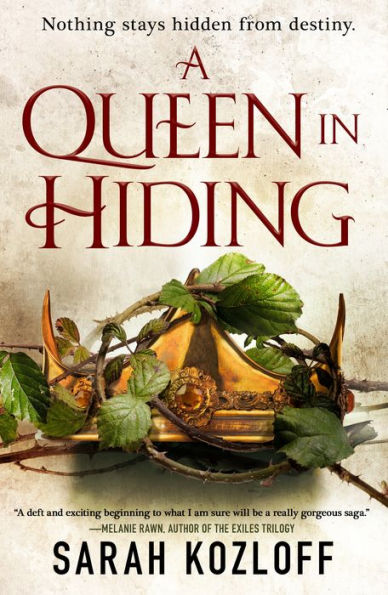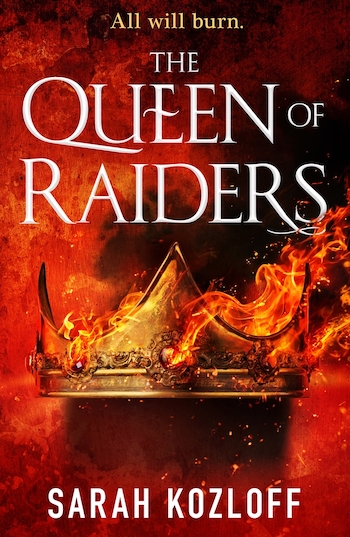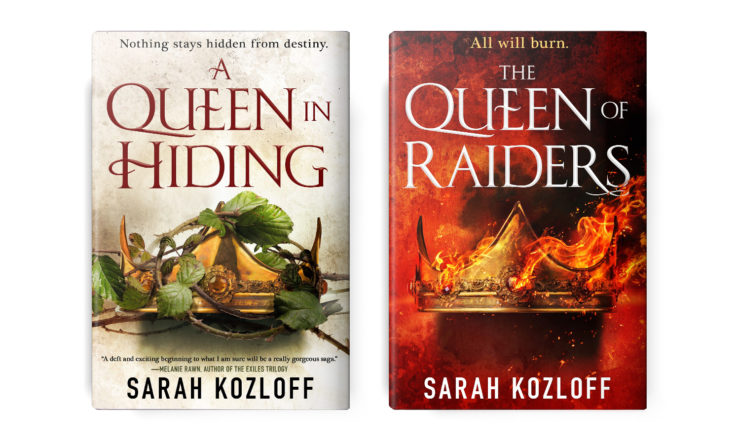A Queen in Hiding and The Queen of Raiders, the first two novels in Sarah Kozloff’s Nine Realms universe, looks back to traditional fantasy narratives and works to recast them for the third decade of the 21st century.
Looking from the viewpoint of 2020, the last five years (using N.K. Jemisin’s award winning The Fifth Season as a watershed here) has seen a burst of innovation in Secondary World Epic Fantasy. This paradigm of Secondary World fantasy, under the sway of Grimdark that centers morally grey characters in an even darker grey world, is now being challenged by Hopepunk. Novels with innovative literary structures and novels with settings and backgrounds bursting forth from beyond “The Great Wall of Europe” are becoming more popular. Authors from the aforementioned N.K. Jemisin, and authors like Evan Winter, Jenn Lyons, Elizabeth Bear, Tasha Suri and others have been unfurling those banners and making new fantasy subgenres available to a wide audience.
But what about fantasy before the 21st Century and the rise of Grimdark? What about the traditional fantasy narratives of the ’70s ’80s and ’90s, Tolkien, first order and second order descendants that shaped fantasy for so long? If you are of a certain age, you’ve read them in plenty. Farm boy (almost always a boy unless you are a writer like Katherine Kerr) discovers that he has a Destiny. Go through trials and troubles, grow to power, right the wrongs of the kingdom or the world, cast away the evil vizier, dark lord, or faceless horde of an army. Take the richly justified reward until Book 2 when the enemy returns (surprise!) or an even greater enemy looms. Lots of characters, point of views from (primarily if not exclusively) the protagonist points of view, paint on a huge canvas, stakes high. This was hardly the entirety of secondary world fantasy in the period, just as Grimdark even at its heights was and is hardly the only secondary world fantasy out there, but it was the dominant paradigm.
While some recent authors have tried to comment and deconstruct that older narrative while keeping what is ostensibly at first that very traditional format, like Lucy Hounsom and her Starless series, returning to that paradigm in a major way seems to be an echo of the past, a curiosity, something of limited interest.
And yet here is Sarah Kozloff with her Nine Realms quartet, published in four consecutive months by Tor Books. The first two novels, A Queen in Hiding and The Queen of Raiders, are currently available, so let’s dive in:
Buy the Book


A Queen in Hiding
A Queen in Hiding starts things off in that relatively familiar, traditional mold. Cérulia, daughter of the Queen of Weirandale, does not have a recognized power (unlike her mother and her female predecessors). As this is happening, the Evil Chancellor (the soon to be Regent Matwyck) schemes with the aid of foreign help, Oromundo (who have their own designs on world conquest) to depose the Queen and take power. His goal is get rid of the current Queen and take control of the ascendant one, given how the Monarchical line has a key tie to the spirit of the land, the Spirit of Fresh Water, Nargis. Without a Queen, those waters may indeed not flow. Queen Cressa manages to escape the trap with her daughter. In a move that makes the series possible but still seems a bit odd to me even two books in, Cressa hides her daughter with a farming family in another portion of her kingdom, and uses her own power to make the family forget her daughter is the Crown Princess. The Queen goes off, winds up getting killed fighting pirates (in a bid to increase her personal power and prestige to take the throne back) and this leaves Cérulia in the “farm girl” role, the only person around who knows what she is—and the Regent, Matwyck, desperately trying to find her.
The theme and style of this first novel is mostly bucolic, showing Cérulia in the role of someone who slowly discovers her real power (or recognizes it as such) and getting a ground level look at what life is like in her kingdom. Given her youth and inexperience, this is a skillful use by the author to cover a few narrative bases–to give her some real world experience, give her a few seasons to grow up, allow her power (to speak to, and in some cases command fealty, from animals) a chance to develop, and it gives her breathing space. Fortunately, from a narrative perspective, since this IS a traditional fantasy, there are plenty of other points of view that the reader can rely on. The world doesn’t stop while Cérulia is hiding, and using a variety of points of view (including Matwyck himself), the author keeps the narrative of events flowing even as her protagonist is hiding. Setting up the chess pieces for the entire series.
And that is a theme of a lot of this novel, this novel does a lot of the heavy lifting in setting up the world, the major players, and the themes and conflicts that appear to be the themes and superstructures of the series. It’s a long opening act, to be sure, the quartet has a Lord of the Rings feel in that A Queen in Hiding definitely does not stand alone. There is no off ramp here, reading the first book and stopping there is and would be a very unsatisfactory experience unless one just wanted to taste what traditional fantasy is like.
The Queen of Raiders jerks us out of the bucolic and setting the stage mode that dominates much of A Queen in Hiding. Continuing the widescreen multiple point of view structure, and adding new PoV characters, Cérulia takes a while to enter the stage. Instead we are in the Free States who are facing the prospect of the Oromundo invasion as they expand ceaselessly and remorselessly in their drive for resources. The weight of the Oromundo military and a lack of coordination between the city states is a recipe for military disaster and conquest. A group of survivors get a cunning plan—if you can’t defeat the army in the field, then the way to give an occupied country a chance is to strike at the homeland, to draw armed forces back to it. Meanwhile, discontent with her farm life, Cerulia takes action, and by turns winds up heading to Oromundo herself to strike at the enemy responsible for aiding the deposing and death of her mother.
There is a bit of strain in how Cérulia ultimately winds up teaming up with the titular Raiders. Given that Oromundo themselves have a struggle in locating the band, even when they start hitting targets, for Cerulia, even aided, to do so with relative ease feels a little bit of a shorthand. However, her experience in neighboring Alpetar, and her treacherous trip into Oromundo is winningly depicted. Having hiked in mountains, her travails in crossing the mountainous border were very evocatively depicted. And here, even more than the fall of the Queen, the author is showing the costs of conflict and the costs of resisting tyranny.
Buy the Book


The Queen of Raiders
The new point of view is from Thalen, citizen of the Free Cities. He goes from loss in battle against the Oromundo to leader of the Raiders seeking to disrupt their homeland enough to relieve the army pressure on the Free Cities. There are some really excellent character touches here, such as his running count of the number of people and horses under his command remaining. Fighting a guerilla war against the Oromundo is an activity fraught with sudden and unexpected death, and it’s a dark duty, one that weighs heavily on him. This gives a horror of war thread through the book that really is effectively conveyed to the reader. It’s that classic traditional fantasy structure power chords at work again. Slow opening, setting the stage in motion, and then plunging characters we’ve gotten to get to know into peril and conflict. Even Matwyck, our major personal antagonist, does not have his Regency and his scheming proceeding quite as he planned. The tagline “All will burn” works on several levels and meanings from the text.
Something else that The Queen of Raiders extends and builds on much more than A Queen in Hiding is the behind the scenes Powers that oversee the land. Mostly hands off aside from chosen champions and avatars, as the second book progresses and events spiral out of control, personality conflicts between the powers come to the fore and their impact on the story becomes more significant and greater. Mind you, Cérulia and the other human characters are still paramount, but they are casting longer shadows by the end of The Queen of Raiders, and far less abstract concepts than they were at the beginning of A Queen in Hiding. Here, they themselves look ready to become players themselves in some fashion.
My major gripe with the series is exterior to the actual books themselves. It revolves around the marketing and how it has been cast. As you have seen above, the two novels are really for the most part far more traditional than the marketing has made it out to be. It does not share any DNA at all with Uprooted, which I have seen press releases try to compare it to, and I think that based on the first two novels, that comparison really is unfair and does a disservice to both readers and the author herself and her works.
Though, this leads to another question: Does classic fantasy, in the tradition of J.R.R Tolkien, Kate Elliott, Melanie Rawn, Terry Brooks, and David Eddings, have a place in the hearts and minds of modern readers? Is this series worth reading? The answer to that question goes back to those expectations as seen above. The Nine Realms series is not necessarily groundbreaking, pushing boundaries on language, structure, point of view, or milieu. The first two novels do include more women than some traditional fantasy, but that ground has also been covered by the (often ignored) women writers of fantasy in the 80s and 90s. But having a new traditional-style fantasy reinforce the need for viewpoints beyond just dudes is no bad thing.
And Kozloff’s Tolkienian mode also helps shift the genre away from the morally universal grey of Grimdark by an appreciable fraction. Given the story so far, the moral arc of the books looks to bend toward justice. I am well invested enough in the series to see how she bends that arc in the subsequent volumes, A Broken Queen and The Cerulean Queen.
A Queen in Hiding and The Queen of Raiders are available now from Tor Books.
A Broken Queen publishes March 24th, with The Cerulean Queen following on April 21st.
An ex-pat New Yorker living in Minnesota, Paul Weimer has been reading sci-fi and fantasy for over 30 years. An avid and enthusiastic amateur photographer, blogger and podcaster, Paul primarily contributes to the Skiffy and Fanty Show as blogger and podcaster, and the SFF Audio podcast. If you’ve spent any time reading about SFF online, you’ve probably read one of his blog comments or tweets (he’s @PrinceJvstin).










